Wildlife of Cambodia
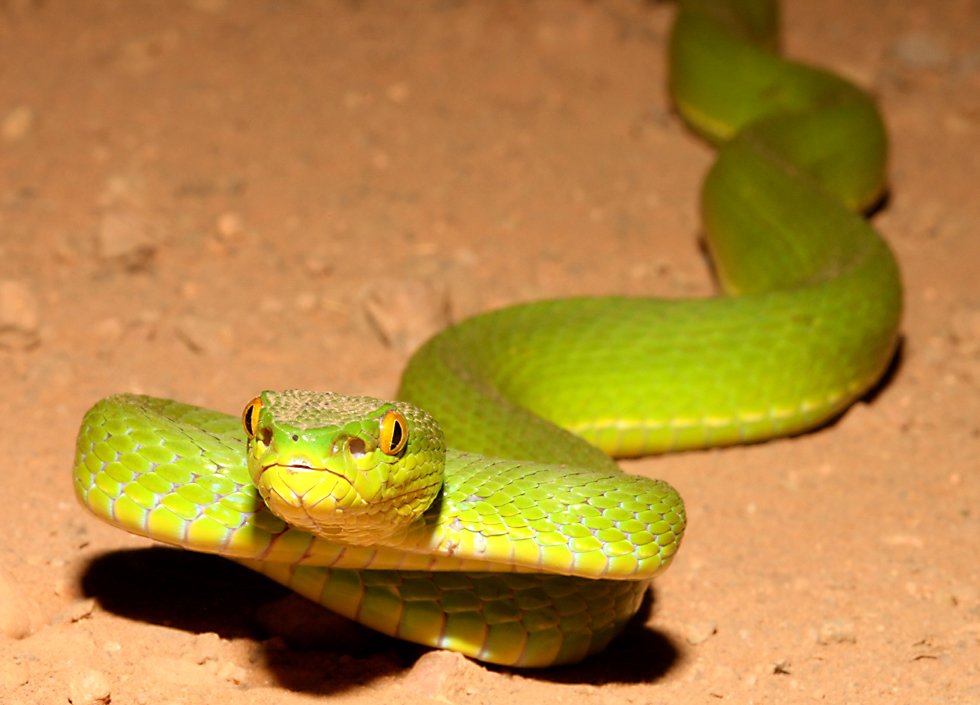
When I visited Cambodia at the end of 2008 I knew I wouldn't see any snakes, because I'd heard grim stories about how 7 million snakes were being killed each year to feed the crocodiles in the crocodile farms which have sprouted around the country. As usual, my snake prognostication skills were utterly off target - I saw more snakes here than any of the other countries in the area that I've been to. I came across this beautiful pit viper on my first day out of Phnom Penh, when I was driving up to Siem Reap. Night was falling as I drove in from the west and there were frequent short detours around many of the bridges which were being rebuilt. On one of these detours I got lost and headed down a single lane dirt road into the surrounding farmland. Suddenly I saw a snake a short distance in front of me, so I slammed on the brakes. I thought I might have run it over, but when I opened the door it slithered past. I picked up my camera and flashlight, but it had already escaped into the long grass beside the road. Continuing on, I spotted this beauty, stopped some distance away, jumped out of the car and started taking photos. When I got a chance to look at the photos I realized that it's a pit viper, and probably quite poisonous. You can see the heat sensing pits at the front of its head which give this family of snakes its name. It wasn't too happy, but it was a bit less than a meter long so I didn't feel too concerned, though I wasn't going to pick it up either! After a while it backed off and headed back from the way it had come. In all I saw 8 or 9 snakes, though I only managed to photograph two. I particularly regret missing out on a very pretty little green and black chequered tree snake that I saw near Chambok waterfall; when I saw its head I thought I was looking at a beetle, and when I moved in to investigate it quickly headed away. |
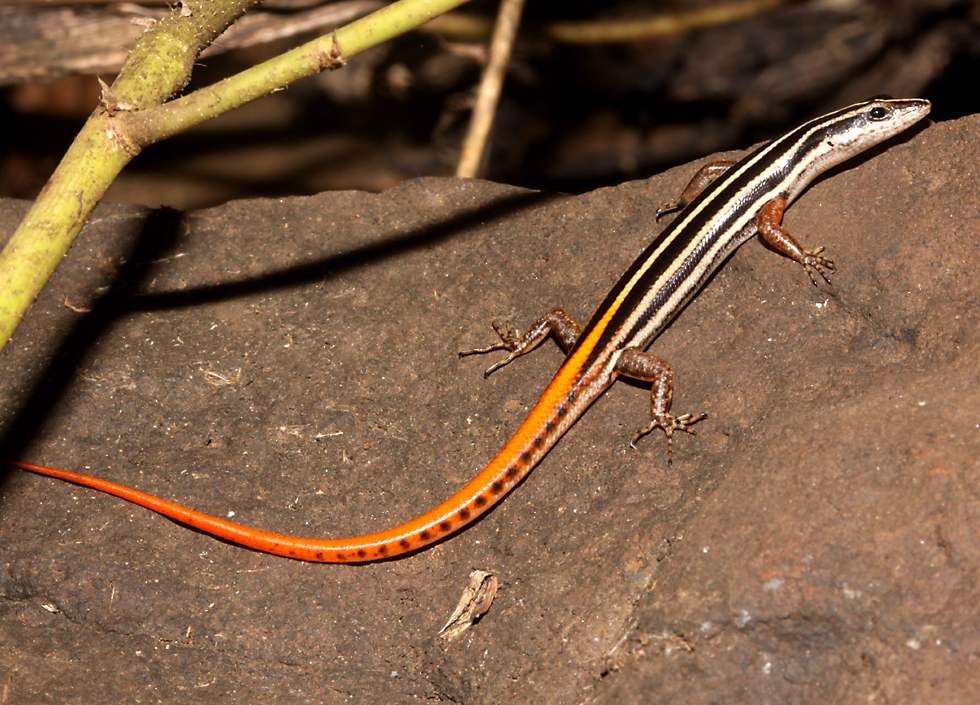
Lizards like this yellow-striped tree skink can be as difficult to photograph as snakes. This particular individual was relatively co-operative, because it was living at the base of the upper tier of Bousra waterfall, and had become acclimatized to all of the people who picnic here. |
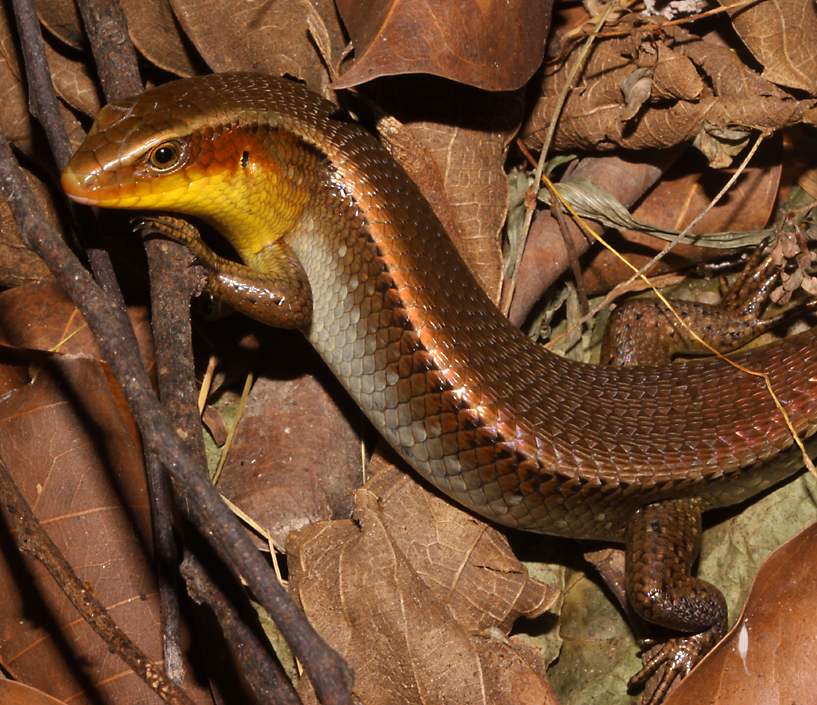
This common sun skink is much larger and not quite as accomodating. It was making its home around the temples in the ancient city of Angkor Thom, one of the biggest tourist hotspots in Cambodia. The ruins are a great place to find reptiles and also beautiful insects, spiders and other bugs. Quite a few of the photos on this page and on the bugs of Cambodia page were taken in that area. |
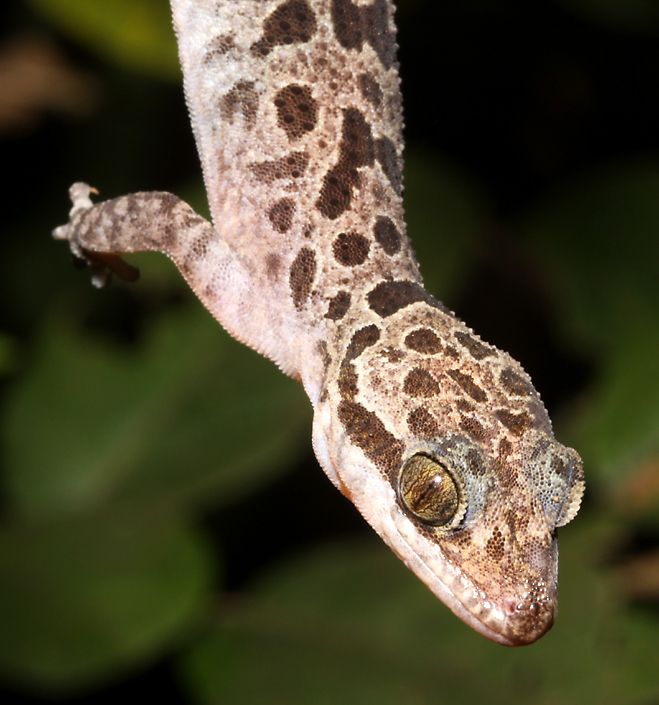
This gecko is a nighttime denizen of the area around Bousra waterfall. When I found it, it was in a small bush beside the road and I took ten or fifteen shots of it there. It then got bored of this treatment and jumped into the blue (or perhaps I should say "into the black") and ended up hanging onto a twig by one of its back feet, as you see here. |
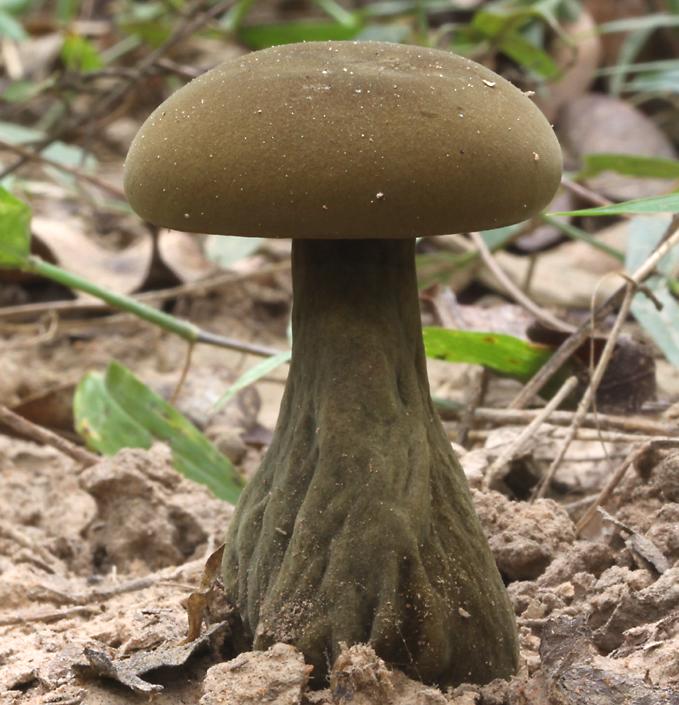
For a change of pace, here's a bolete mushroom on the trail up to Chambok waterfall. What, I hear you saying, does a mushroom have to do with Cambodian wildlife? Well, it is a wild mushroom and it is alive, so I figure it belongs here. And anyway, I don't have anywhere else to put it. |
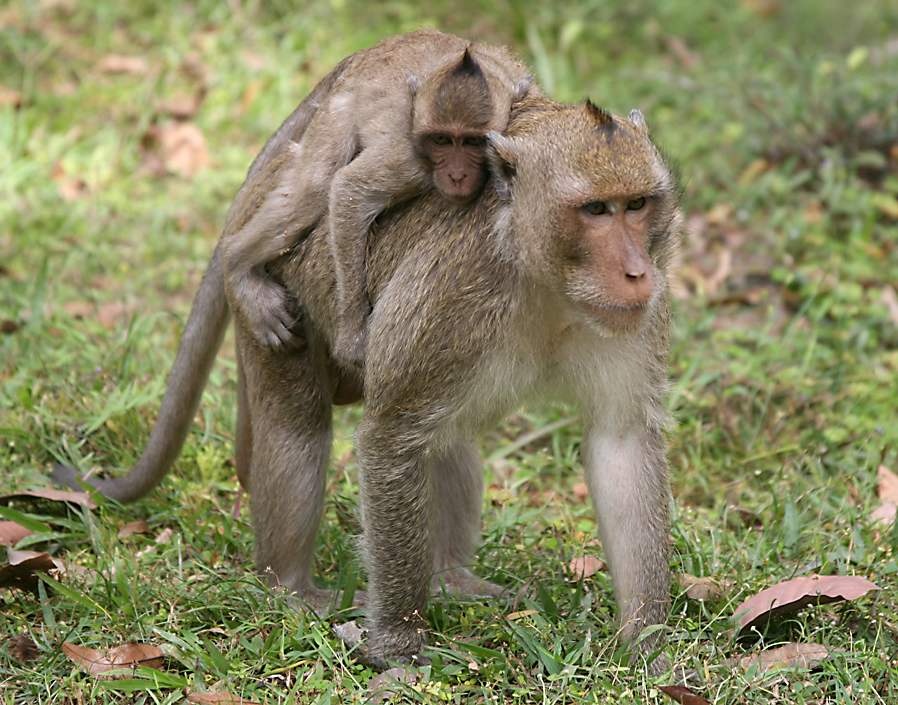
I don't often get to photograph many mammals when I travel, but I did get a few nice shots here. Of course, some mammals are easier to photograph than others. Long-tailed macaques like these are very much at home with people, you can even photograph them at Wat Phnom in the middle of Phnom Penh. You might guess that this is a mother and child, but you'd be wrong. This is a male which picked up the juvenile a couple of minutes before I took this photo beside the road at Angkor Thom. Initially the baby protested vociferously, but then gave up and acquiesced to being carried around. Goodness knows why the male did it, whether it was simply nurturing instinct, some sort of hierarchical power display or something else. |
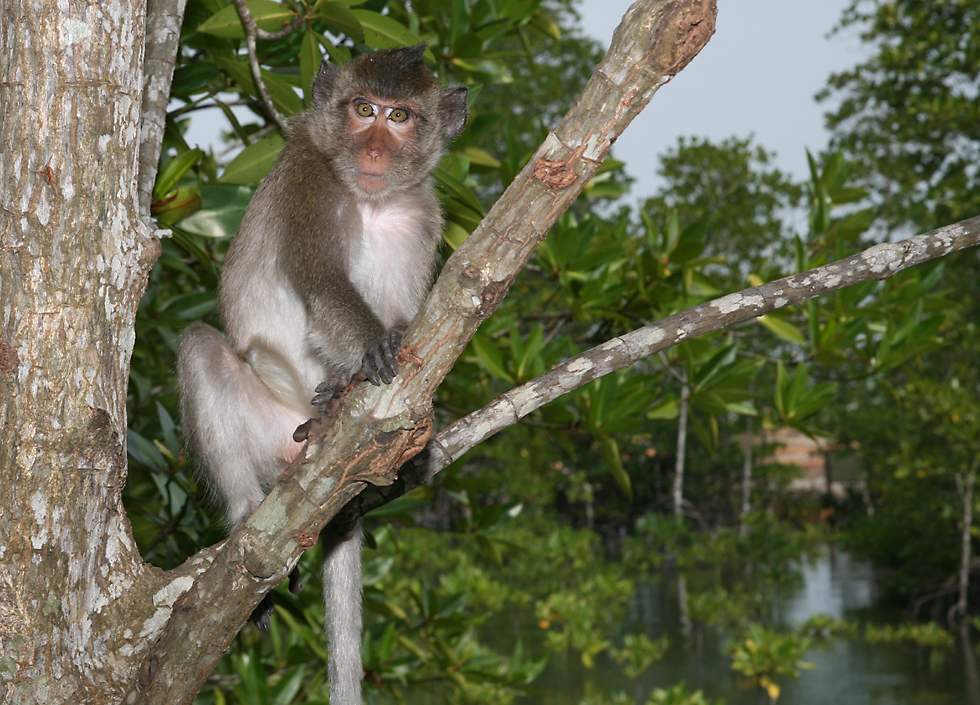
The long-tailed macaque is also commonly called the crab-eating macaque. This female is in mangrove forest near the town of Krong Koh Kong, very near the border with Thailand. The mangroves are prime habitat for finding crabs and other food, but this one was a bit more devious, stealing a bun from someone eating in the local restaurant! This sort of behavior makes these monkeys a considerable nuisance in some places. |
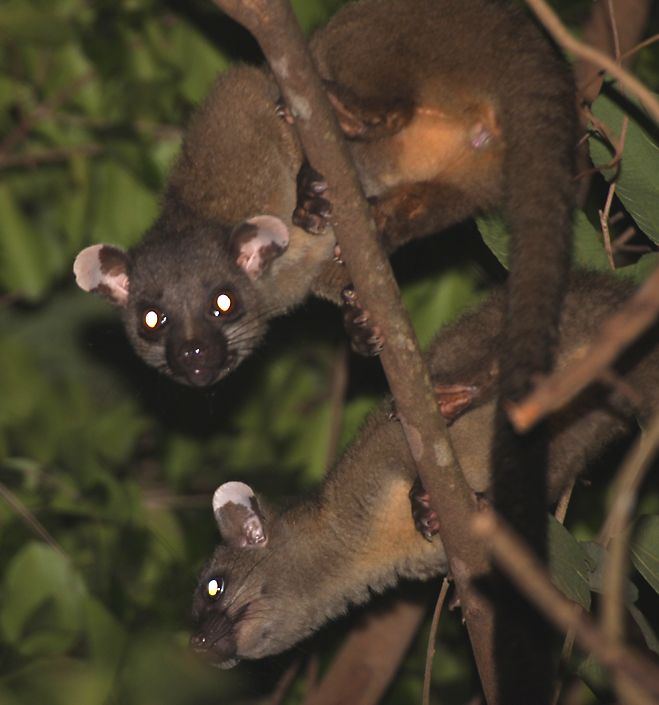
These are civets roaming around at night in Kep national park. This is actually a mom and pop, with four young in tow. They were nervously keeping an eye on me while moving ahead of their brood, and calling out to them to encourage them to move forward. I was surprised that they were able to move so easily through the trees, because it was very dark. I photographed a different type of civet in Vietnam's Cat Tien national park, and now I'm not sure of the identification of either species! |
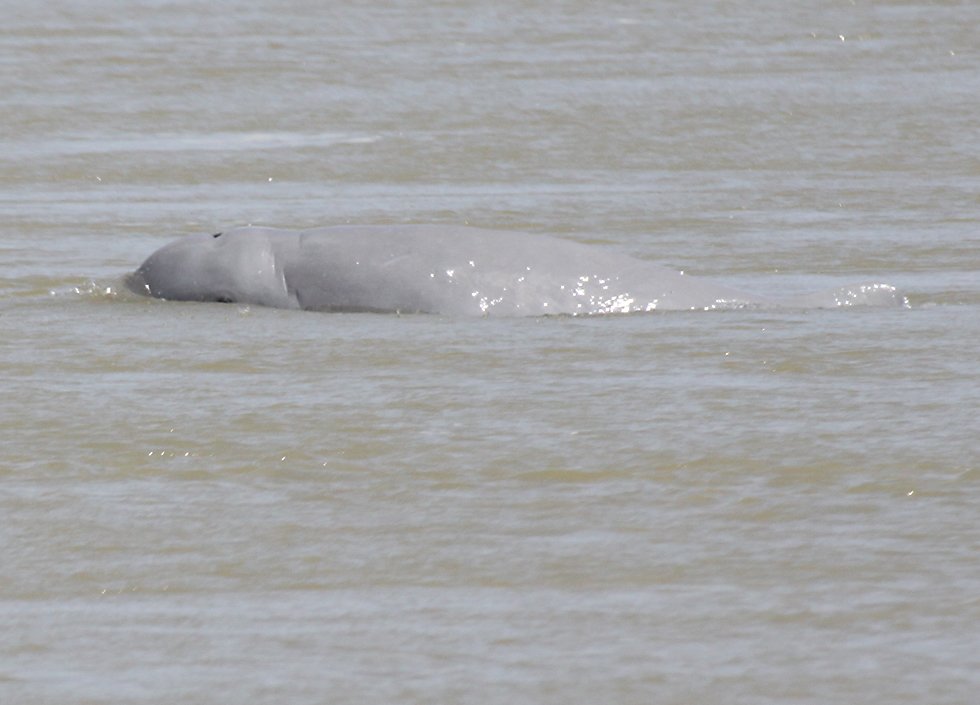
This trip is one of the few times I've gone out of my way to seek mammals to photograph. The village of Kampi, about 10 or 15 kilometers north of the town of Kratie, is a reliable place to find the endangered Irrawaddy River dolphin, which lives in both fresh water and brackish water near the coast, all the way from India down to Australia. It's not at all easy to photograph because it only surfaces for two or three seconds every two or three minutes. The Mekong River is very muddy, so you can't know where it will appear next. I took about 250 photos with a 400mm lens and high-speed multiple exposures, but this is the only one where its eye is visible. I never got to see the tail, apparently they only raise it out of the water if they're about to dive deeply. |

I was lucky enough to have a mother and its baby in the area when I visited. The Latin name of this dolphin is Orcaella brevirostris, and surprisingly it is indeed closely related to the much larger orca or killer whale. The second part of the name means "short nose", which you can see from this juvenile is very appropriate. Unfortunately, this species is critically endangered in most of its range, with an estimated worldwide population of about 7000, of which 90% live in Bangladesh. Individuals often die when accidentally caught in fishing nets, and there might be some illegal hunting. In Cambodia the dolphins are legally protected by the government, and because they're now a tourist attraction the local population actively looks after them. |

Photographing reptiles, mammals and birds is always hit and miss, both because they're often difficult to locate but also because you need skill to photograph them. On the other hand, wherever you go you can be sure of seeing plenty of interesting bugs. Getting good shots of them is another matter and like the other types of wildlife photography, it requires the use of some tricky stalking and photographic techniques! It's not enough just to have the right equipment, you also need to know how to use it. This peacock pansy is quite common throughout Asia, but it's a bit flighty so it isn't very easy to photograph. |
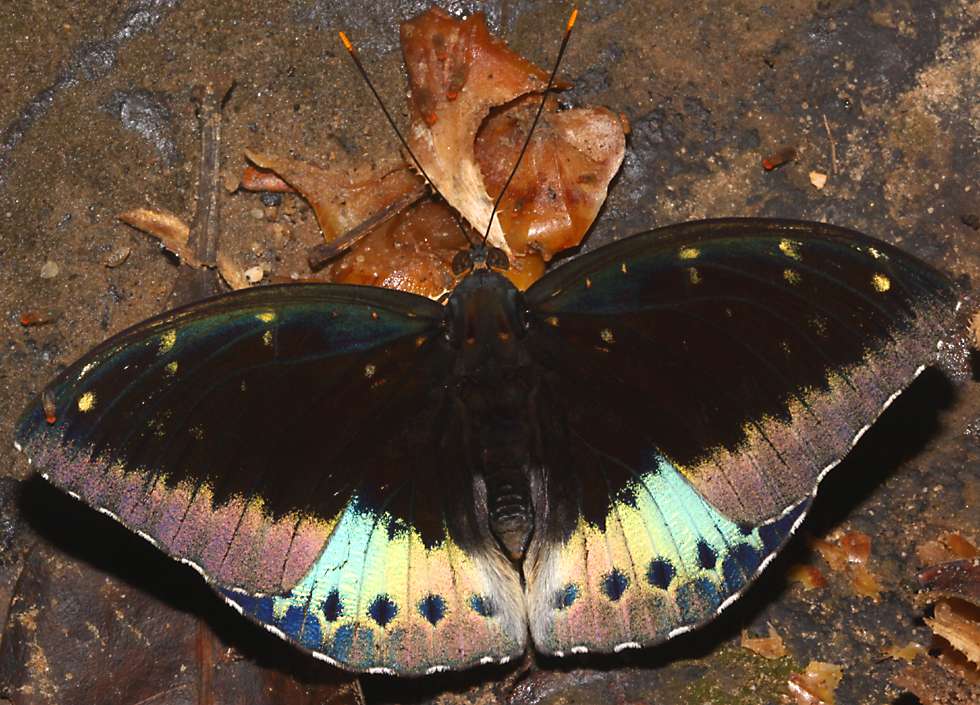
This beauty is a male archduke butterfly Lexias pardalis which I chased for ten minutes while walking around Angkor Thom. The females have a completely different color scheme, you wouldn't even know that they're the same species. Until I was preparing this photo I didn't notice that the butterfly is surrounded by several tiny flies with red eyes. There's even one standing on the tip of the butterfly's left front wing. It's such a beautiful butterfly that it's commercially farmed for selling to collectors. This is much better than collecting them in the wild, which is a major threat to many tropical bugs. |
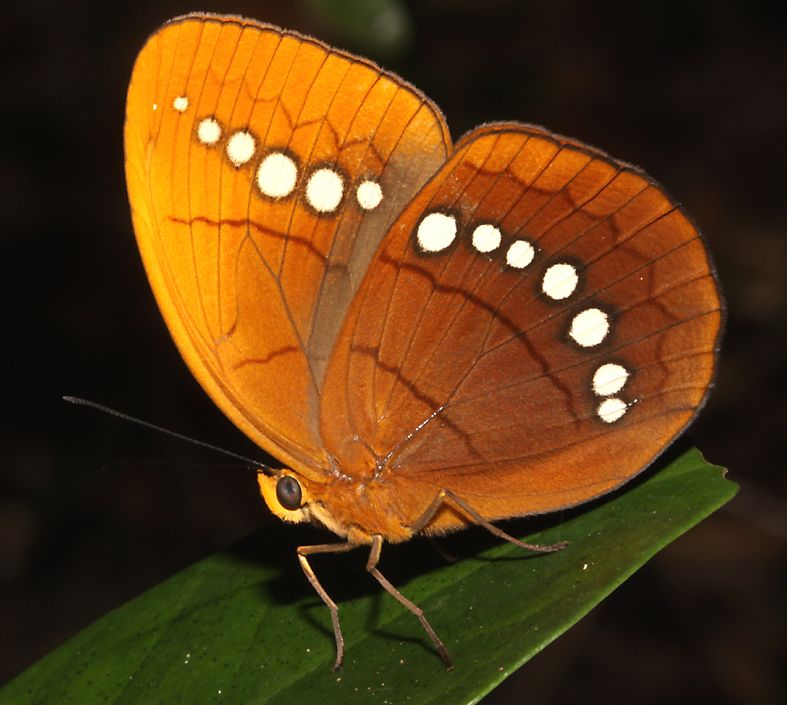
I found this large faun in the late evening below the lower tier of Bousra waterfall. With this particular butterfly the undersides of the wings are more interesting than the top surfaces, which are a plain orange and brown. |

This isn't a particularly colorful butterfly, but it is fairly special. This male dark glassy tiger butterfly was fluttering around with three or four others in the early evening in Kep national park. The tigers and their close relatives the crows belong to the same family as the monarch butterfly of North America. However, unlike the monarch they're difficult to approach and even more difficult to photograph with their wings open (you can see a tiger with its wings closed and one with its wings partly open on the Butterflies of Vietnam page). That's why it was so nice to get this photo at Kep, with the added bonus of an uncluttered background. I had to wait about 20 minutes for this butterfly to settle, and then I had to very slowly approach so it wouldn't fly away (which it did, three or four times). Another thing which makes this photo so special is that this individual has pushed out its coremata, the brush-like hairs which you can see protruding from the back of its abdomen. These hairs, which are also found in moths, help to dissipate the phermones which the males use to attract females. It's not often that you get to see coremata, out of many thousands of butterfly and moths photos I think this is my only one which shows them. |
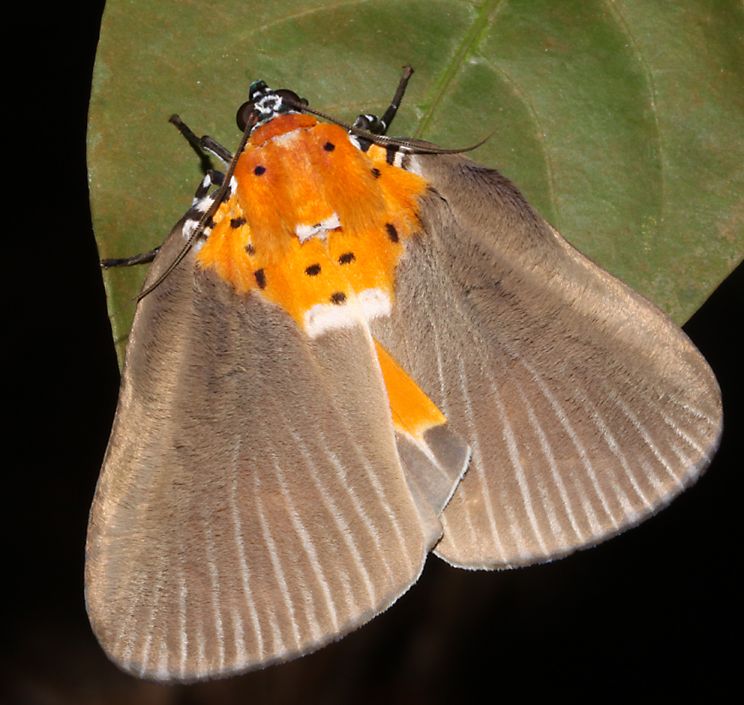
As I've mentioned elsewhere, Kep was also an excellent place for moths, like this spectacular owlet moth in the genus Anagnia. Not only does it have spectacular colors and patterns, this species is also amazingly furry! |

A beautiful inchworm, or caterpillar of the geometrid moth family. This particular one is a Dysphania militaris which I photographed at night at Ream on the south coast, on a fairly fruitful excursion along a path into some ordinary-looking secondary forest which I noticed while driving. It's the juvenile of an equally attractive day-flying moth. |

Back at Bousra, this is a tussock moth caterpillar called Calliteara horsfieldii which I photographed at night fairly near the gecko you've already seen. I've photographed this same species in Vietnam. It's recognizable as a tussock moth because of the "tussocks" or tufts of hair on its back. As well as the long hairs and creamy color, this species is very recognizable because of the large black spot between the first and second tussock, which the caterpillar displays when it feels threatened. How anything is meant to see this black spot at night is completely beyond me! Personally I didn't find the spot very threatening, but it must give pause to birds and other predators. The hairs, which contain irritating chemicals, also keep predators away; their mere presence probably help keep parasitic wasps at bay, a huge threat to any caterpillar. |

I took a huge number of interesting bug photos in a large patch of weeds by the side of the road at Angkor. I spent a couple of hours there while I was waiting for the sky to clear up so I could take photos of the many temples in the area. I have very little interest in botany, but the leaf that the dragonfly is standing on explains why this was such a productive place. It belongs to a vine called Mikania micrantha which has hundreds of small flowers which attract nectar-loving insects. Butterflies love it as much as the "butterfly bush" called lantana, which is native to tropical Africa and the Americas. You can find it all over south-east Asia and its always a great place to find butterflies and other bugs. Like lantana, Mikania micrantha is a very destructive invasive weed which spreads far and wide and smothers other plants. That's why it's sometimes called mile-a-minute weed, in addition to its other common names of bittervine, Chinese creeper and American rope. It certainly deserves the mile-a-minute name, because it can grow as much as 8 centimeters in only 24 hours! |
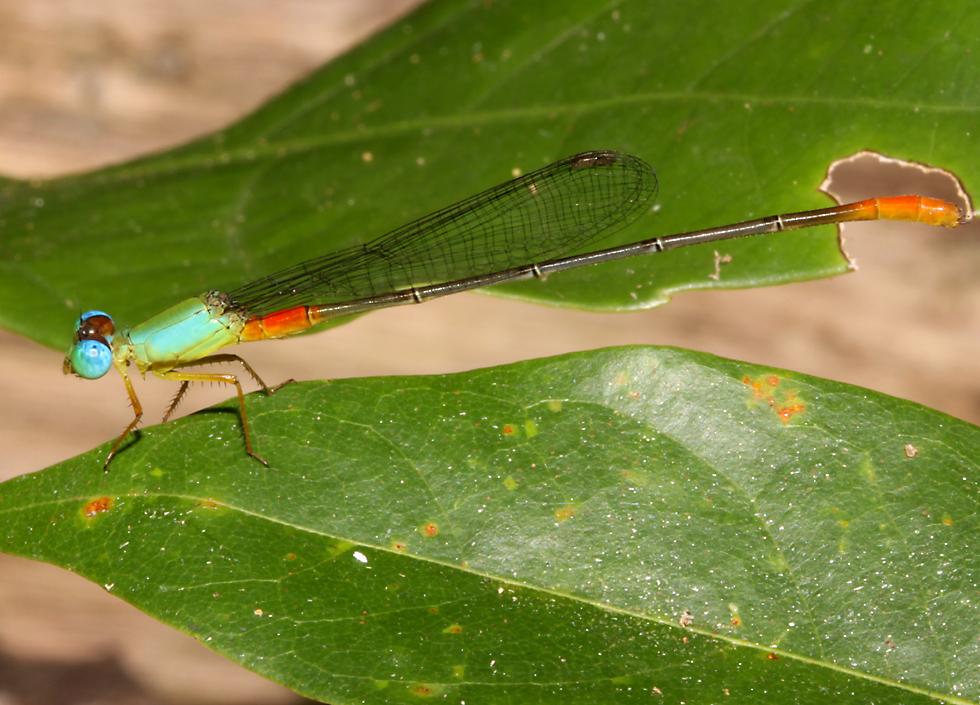
Here's a beautiful damselfly with an equally beautiful name, the orange-tailed marsh dart. It's a very recognizable species, because no others have the same combination of colors. It's also a very aggressive predator, sometimes catching and consuming other damselflies which are twice its size. |

Another beautiful damselfly. This one was at the pool below the upper tier of Bousra waterfall, a very good place for both dragonflies and damselflies. |
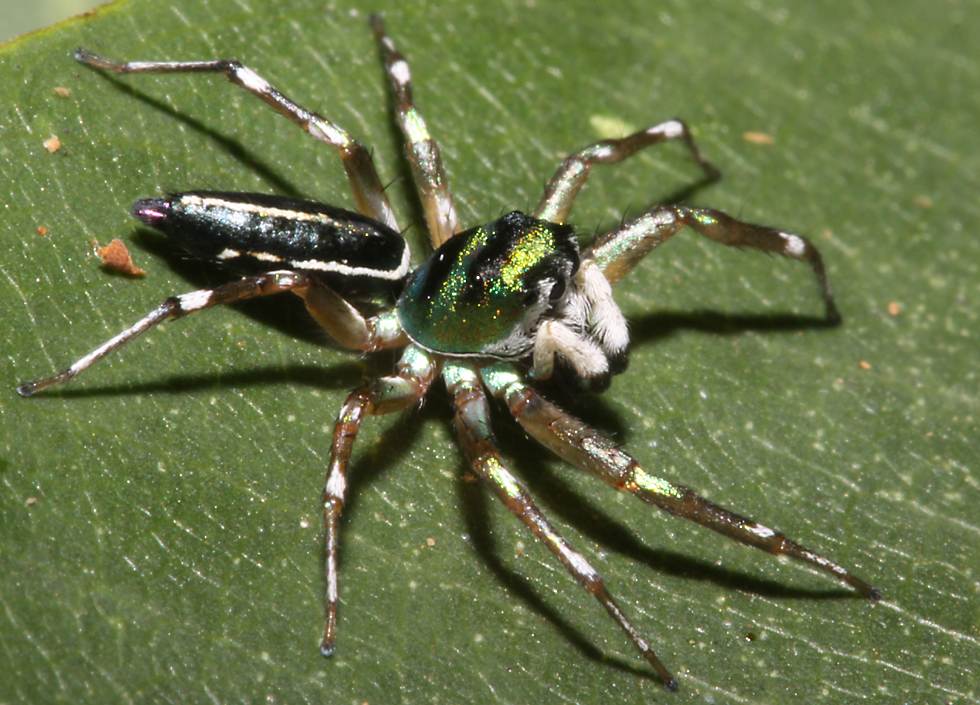
There were plenty of cool spiders in Cambodia, and if I can find the time I'll put together a separate page of them. Until then, spider junkies will just have to make do with this page of Vietnamese spiders. This one is a nice little jumping spider called Cosmophasis umbratica, which includes ants in its diet. In English it's sometimes called the "shiny jumping spider". I like the way its purple butt complements its beautiful iridescent green head and legs. Male spiders of this species reflect ultraviolet light, but females don't, and it's thought that this is to make the males more attractive to females during courtship. |

I was surprised that I couldn't identify this spectacular lynx spider, which is much larger than the jumping spider. Jumping spiders and lynx spiders are both large families with many colorful species. There were several of these spiders in the same mile-a-minute weed patch as the dragonfly, you can see one which has caught a beautiful tiger moth, not realizing until it tasted it that it was toxic. This one is too busy guarding its egg sac to hunt.
|

Back to Ream, here's a stink bug nymph hanging out at night with a beetle. It's very common to walk around for 15 minutes without seeing anything significant and then you come across situations like this with several things in one place! |
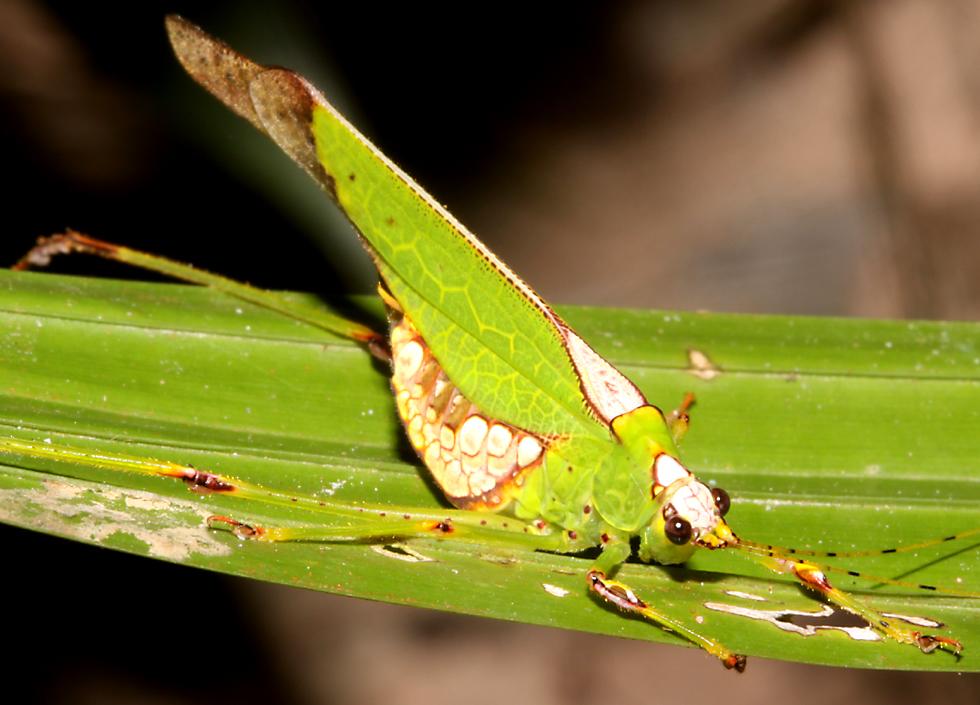
This female bush cricket or katydid is another inhabitant of the same path at Ream. You can see an even more attractive bush cricket in the same area on the Cambodian bug page. The color pattern on this cricket is an attempt to look like a dead leaf, as is the peculiar posture it adopted when it saw me. You can clearly see the hooks at the ends of its legs which many bugs use to hang on to leaves and other vegetation. You can also see this cricket's ears, which are the bulges below the knees of its front legs! |
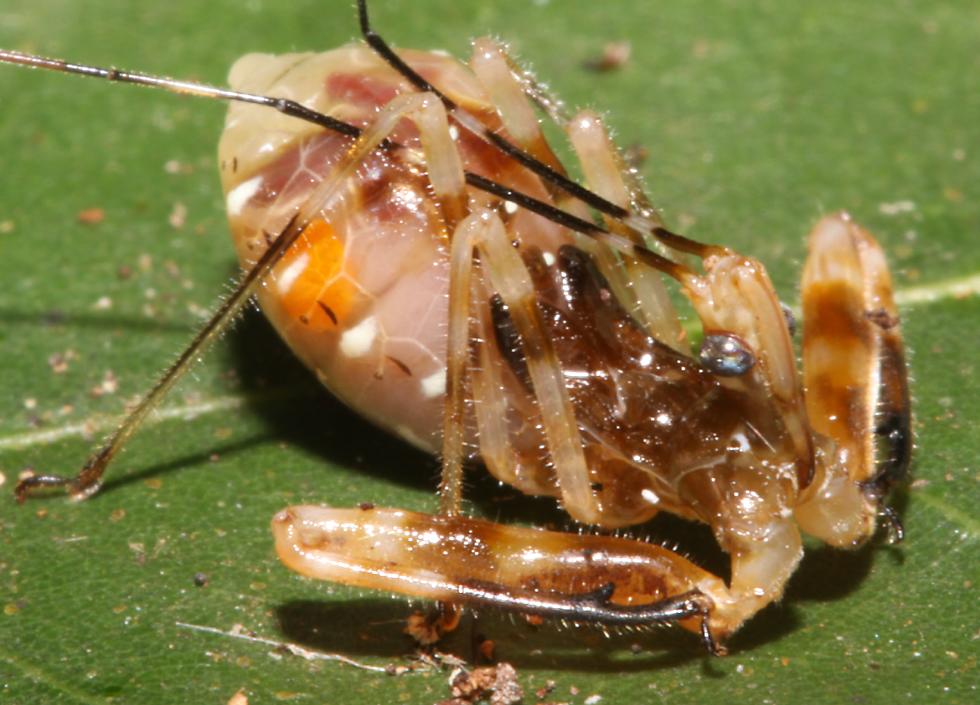
No-one can accuse this assassin bug of being attractive! Like the katydid, it has these ugly colors and weird posture because it is attempting to mimic something else. In the case of the katydid it was a leaf, but here it's a bird dropping! It has even pulled its head and legs far back to break up its normal outline. This might seem very strange, but there are actually many creatures which imitate bird droppings, including many caterpillars and even a moth which I photographed in Vietnam. The main advantage of looking like a bird dropping is that predators like birds don't eat their own droppings or anyone elses! In the case of a predator like an assassin bug, it also means that unsuspecting prey will often walk up to it, allowing it to attack when it's in easy striking range. In that case it will plunge the long straw-like mouth piece you can see here into the insect it has caught, and suck it dry. |
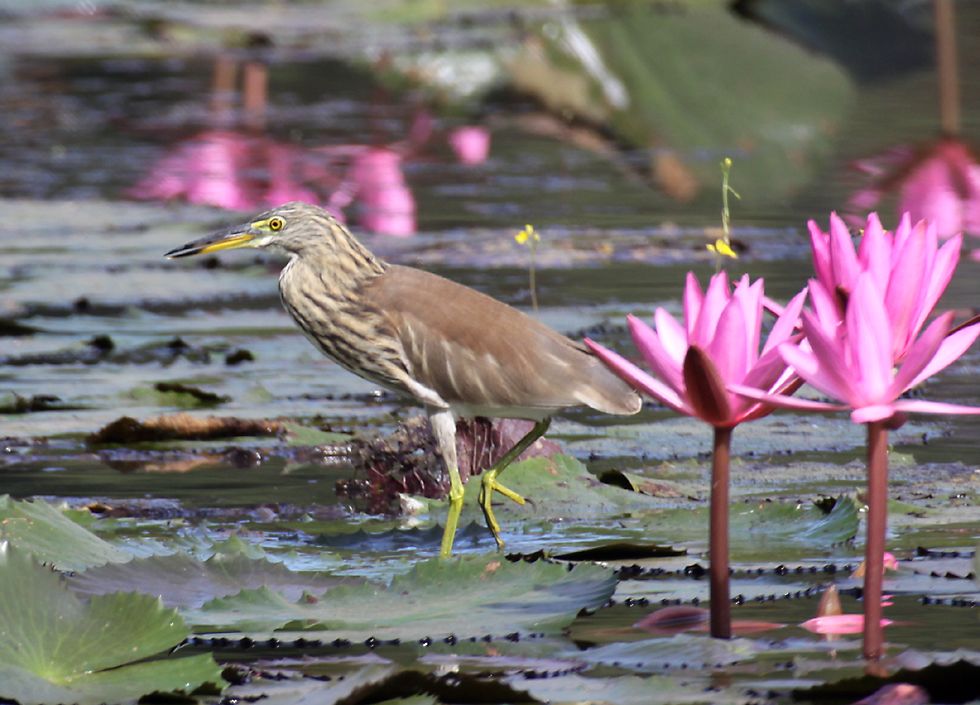
The geography of Cambodia is dominated by the Mekong river and by a connected lake called Tonle Sap, which is a particularly good place to find birds. I went to visit the famous bird sanctuary on Tonle Sap called Prek Toal, but I was put off by the price. I should probably have joined a tour group and done it that way. However there are other places to see birds, this Chinese pond heron was hunting in a pond outside the moat at Angkor Wat, along with a dozen others. |
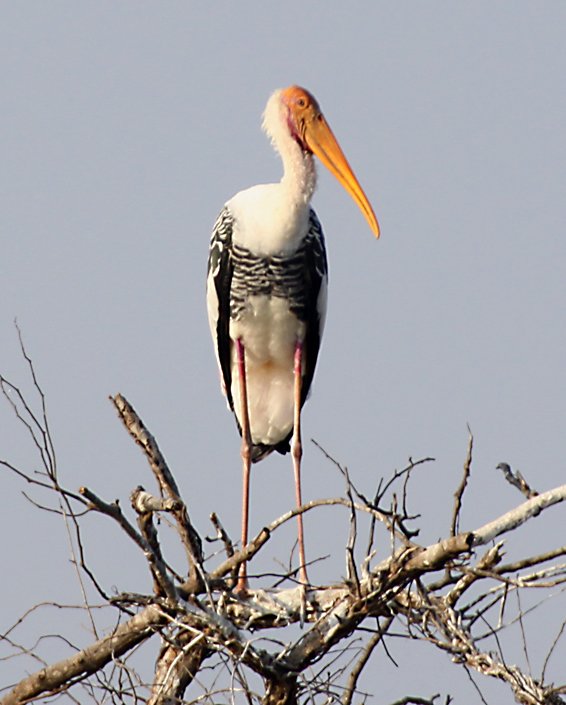
This painted stork was at another good birding site called Ang Trapeng Thmor, which is difficult to find on your own, even if you ask directions from local villagers or policemen, as I did! This is one of the few places in the world where you can find the rare sarus crane, however I was there at the start of January and the cranes don't arrive until a few months later. |
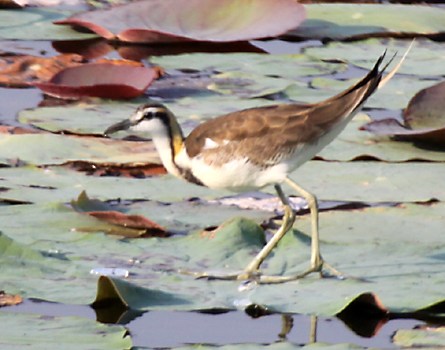
Unfortunately, when I got home I realized that my long lens wasn't working correctly, so none of the long-range photos of birds at Ang Trapeng Thmor or elsewhere are sharp. It's a shame, because there were some nice birds, like the stork, some pelicans and this jacana. When I got home and had the lens serviced they had to replace the barrel, which means I must have bent it pretty badly at some point! |
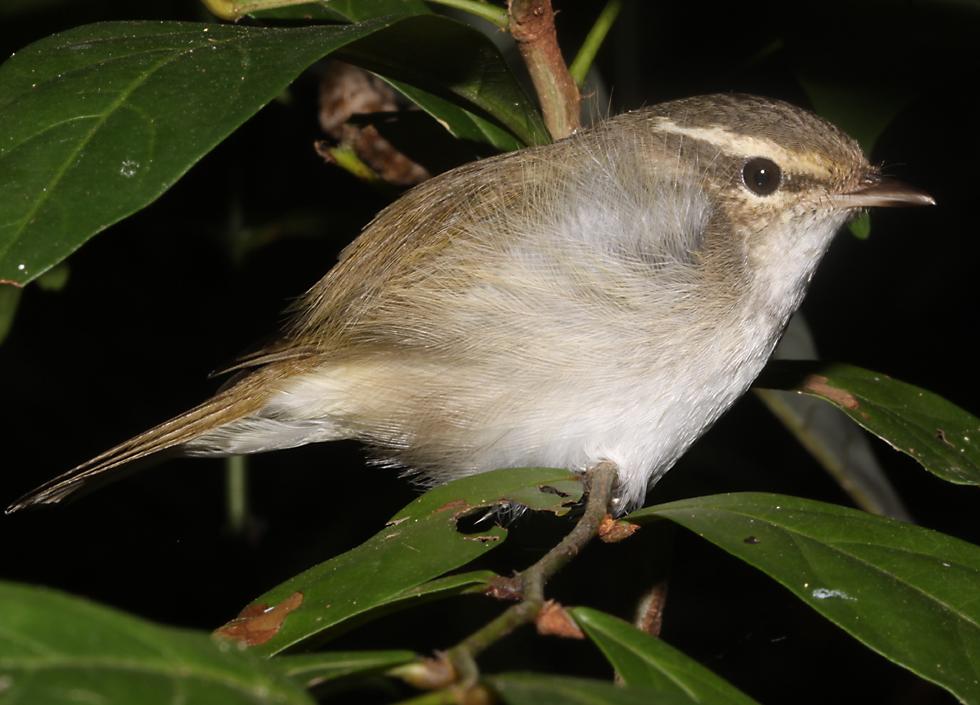
This bird looks plenty sharp, so what's the story? I didn't take this photo using my long lens, instead I used the 100mm macro lens which all of the bug photos were taken with. This bird was along the same path at Ream as the various bugs you've seen on this page, but it was sleeping! It was less than a meter off the ground in a small bush, which I would think would make it vulnerable to snakes cruising around at night. When I first saw it near the start of my walk, the bird was tucked up into a little ball with its head under its wing. After a few flash photos it woke up but let me continuing taking shots until I'd had enough. When I came back three hours later it was sleeping again in the same spot. It's not totally uncommon to find sleeping birds in the forest. Birds only use nests when they're raising young, the rest of the time they sleep out on a branch. This one is a bit dull, but you can see a much more spectacular sleeping oriental dwarf kingfisher on my Thailand wildlife page. |
